Ragic provides a simple validation mechanism via regular expressions. If you know how to write regular expressions, you can create one to validate user input.
Select the field from Design Mode, navigate to Field Settings in the left sidebar, and click on the Validation tab. You can then enter regular expressions in the Validation field.
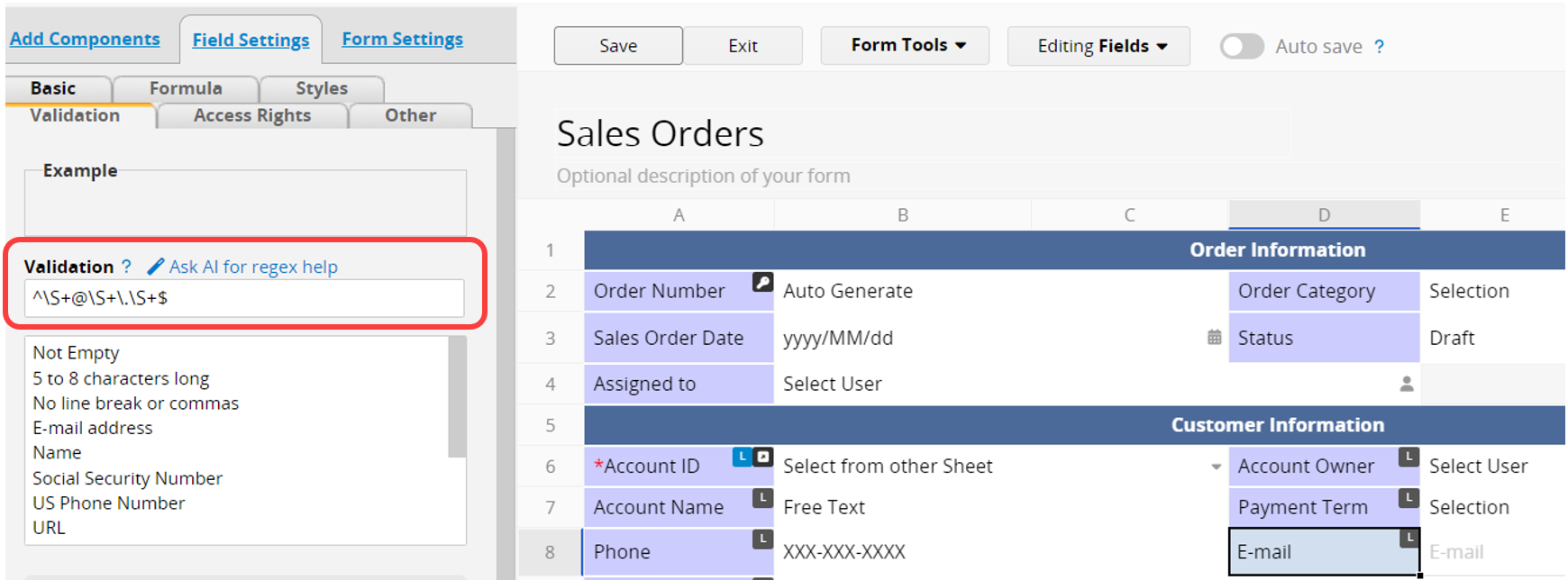
If you are unfamiliar with regular expressions, you can choose a validation template from the sample box or apply conditional formulas as a workaround.
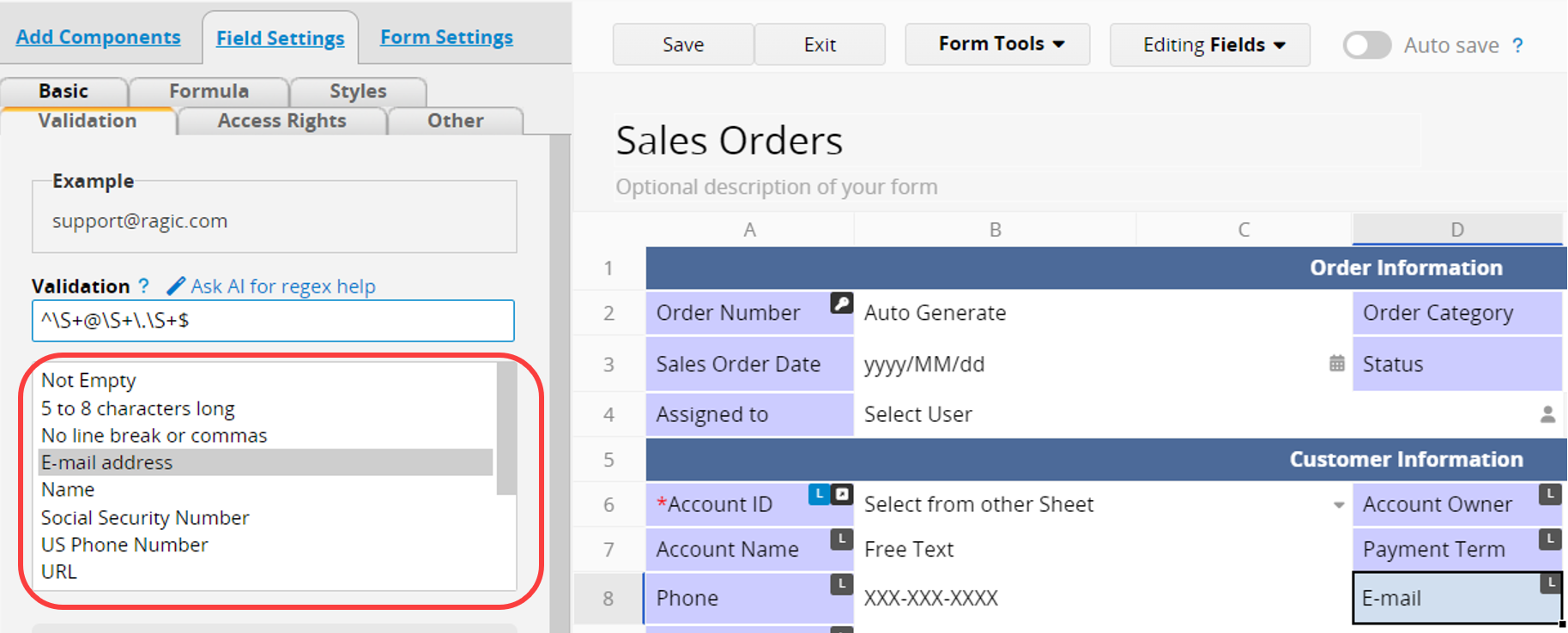
When users enter an incorrect value in this field, an error message will pop up, and the record cannot be saved.
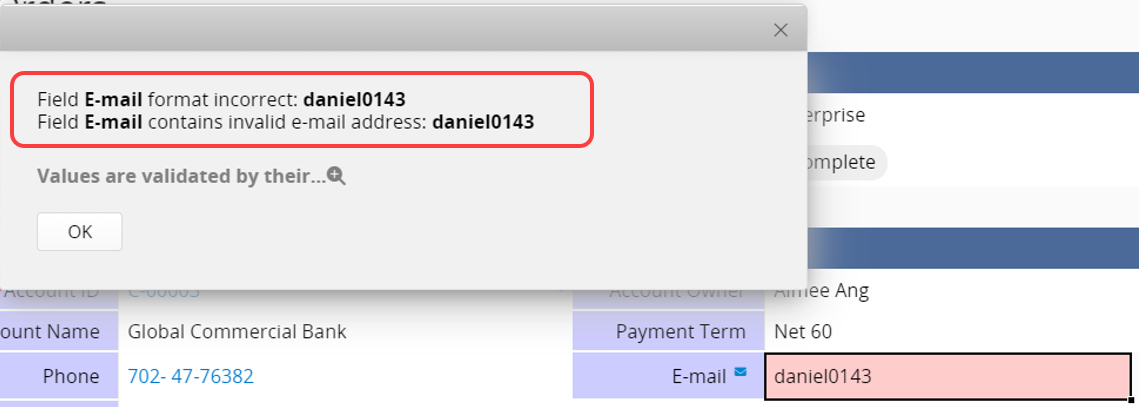
Additionally, you can customize the error message below.
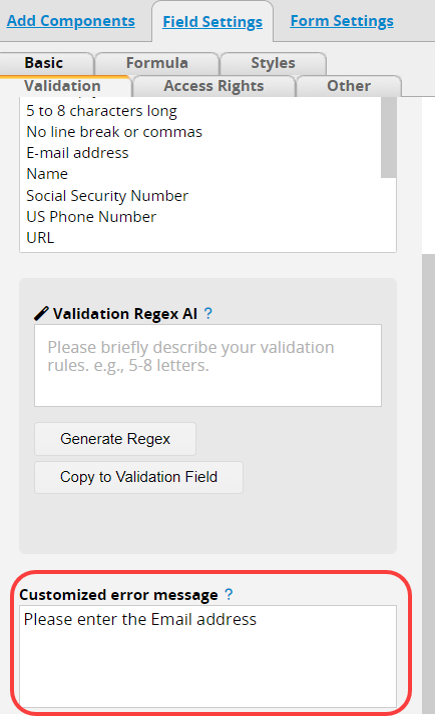
You can ask AI to help you create regular expressions (regex). Your requirements should be concise and clear. For example, if you want to restrict the field value to have the first 3 characters as numbers and the last 3 characters as letters, you can specify it as "First 3 characters are numbers, last 3 characters are letters".
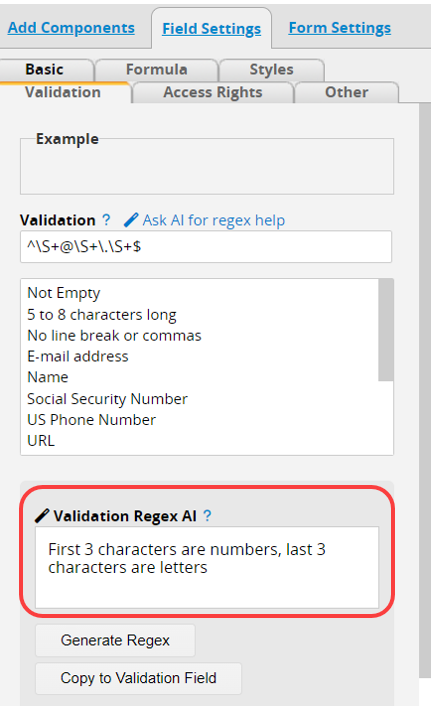
Click Generate Regex, it will automatically create a regular expression. Then, by clicking Copy to Validation Field, you can copy the syntax into the Validation field.
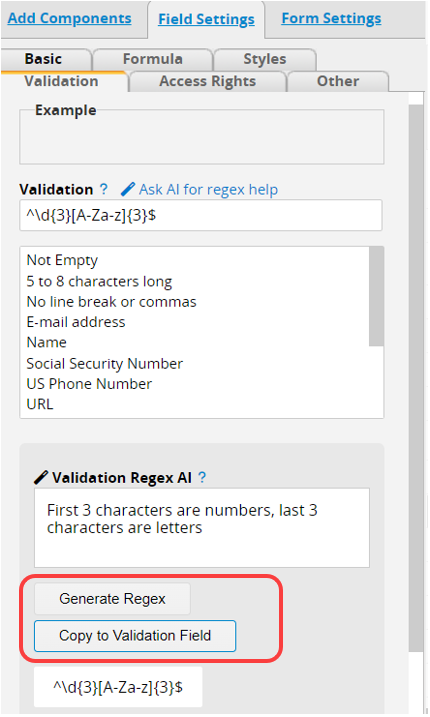
After finishing the configuration, remember to save the design.
You can use a regular expression in the validation tab to check the number of characters entered.
For example, the regular expression "^.{6,7}$" will validate that the input in this field has a minimum of 6 characters and a maximum of 7.
You may also set it to a maximum, such as "^.{0,7}$" (a maximum of 7 characters), or a minimum, "^.{6,}$" (a minimum of 6 characters).
You can ensure users fill in a field in a specific language by using the validation with a regular expression that checks the input against a language code range.
For example, if you want to ensure the input is in "Cyrillic", you can use: [\u0400-\u04FF\u0500-\u052F].
Below is a list of language code ranges for each language. You can also go to this link for more references.
| Code | Language |
|---|---|
| 0000-007F | Basic Latin |
| 0080-00FF | Latin-1 Supplement |
| 0100-017F | Latin Extended-A |
| 0180-024F | Latin Extended-B |
| 0250-02AF | IPA Extensions |
| 02B0-02FF | Spacing Modifier Letters |
| 0300-036F | Combining Diacritical Marks |
| 0370-03FF | Greek and Coptic |
| 0400-04FF | Cyrillic |
| 0500-052F | Cyrillic Supplement |
| 0530-058F | Armenian |
| 0590-05FF | Hebrew |
| 0600-06FF | Arabic |
| 0700-074F | Syriac |
| 0750-077F | Arabic Supplement |
| 0780-07BF | Thaana |
| 07C0-07FF | NKo |
| 0900-097F | Devanagari |
| 0980-09FF | Bengali |
| 0A00-0A7F | Gurmukhi |
| 0A80-0AFF | Gujarati |
| 0B00-0B7F | Oriya |
| 0B80-0BFF | Tamil |
| 0C00-0C7F | Telugu |
| 0C80-0CFF | Kannada |
| 0D00-0D7F | Malayalam |
| 0D80-0DFF | Sinhala |
| 0E00-0E7F | Thai |
| 0E80-0EFF | Lao |
| 0F00-0FFF | Tibetan |
| 1000-109F | Myanmar |
| 10A0-10FF | Georgian |
| 1100-11FF | Hangul Jamo |
| 1200-137F | Ethiopic |
| 1380-139F | Ethiopic Supplement |
| 13A0-13FF | Cherokee |
| 1400-167F | Unified Canadian Aboriginal Syllabics |
| 1680-169F | Ogham |
| 16A0-16FF | Runic |
| 1700-171F | Tagalog |
| 1720-173F | Hanunoo |
| 1740-175F | Buhid |
| 1760-177F | Tagbanwa |
| 1780-17FF | Khmer |
| 1800-18AF | Mongolian |
| 1900-194F | Limbu |
| 1950-197F | Tai Le |
| 1980-19DF | New Tai Lue |
| 19E0-19FF | Khmer Symbols |
| 1A00-1A1F | Buginese |
| 1B00-1B7F | Balinese |
| 1D00-1D7F | Phonetic Extensions |
| 1D80-1DBF | Phonetic Extensions Supplement |
| 1DC0-1DFF | Combining Diacritical Marks Supplement |
| 1E00-1EFF | Latin Extended Additional |
| 1F00-1FFF | Greek Extended |
| 2000-206F | General Punctuation |
| 2070-209F | Superscripts and Subscripts |
| 20A0-20CF | Currency Symbols |
| 20D0-20FF | Combining Diacritical Marks for Symbols |
| 2100-214F | Letterlike Symbols |
| 2150-218F | Number Forms |
| 2190-21FF | Arrows |
| 2200-22FF | Mathematical Operators |
| 2300-23FF | Miscellaneous Technical |
| 2400-243F | Control Pictures |
| 2440-245F | Optical Character Recognition |
| 2460-24FF | Enclosed Alphanumerics |
| 2500-257F | Box Drawing |
| 2580-259F | Block Elements |
| 25A0-25FF | Geometric Shapes |
| 2600-26FF | Miscellaneous Symbols |
| 2700-27BF | Dingbats |
| 27C0-27EF | Miscellaneous Mathematical Symbols-A |
| 27F0-27FF | Supplemental Arrows-A |
| 2800-28FF | Braille Patterns |
| 2900-297F | Supplemental Arrows-B |
| 2980-29FF | Miscellaneous Mathematical Symbols-B |
| 2A00-2AFF | Supplemental Mathematical Operators |
| 2B00-2BFF | Miscellaneous Symbols and Arrows |
| 2C00-2C5F | Glagolitic |
| 2C60-2C7F | Latin Extended-C |
| 2C80-2CFF | Coptic |
| 2D00-2D2F | Georgian Supplement |
| 2D30-2D7F | Tifinagh |
| 2D80-2DDF | Ethiopic Extended |
| 2E00-2E7F | Supplemental Punctuation |
| 2E80-2EFF | CJK Radicals Supplement |
| 2F00-2FDF | Kangxi Radicals |
| 2FF0-2FFF | Ideographic Description Characters |
| 3000-303F | CJK Symbols and Punctuation |
| 3040-309F | Hiragana |
| 30A0-30FF | Katakana |
| 3100-312F | Bopomofo |
| 3130-318F | Hangul Compatibility Jamo |
| 3190-319F | Kanbun |
| 31A0-31BF | Bopomofo Extended |
| 31C0-31EF | CJK Strokes |
| 31F0-31FF | Katakana Phonetic Extensions |
| 3200-32FF | Enclosed CJK Letters and Months |
| 3300-33FF | CJK Compatibility |
| 3400-4DBF | CJK Unified Ideographs Extension A |
| 4DC0-4DFF | Yijing Hexagram Symbols |
| 4E00-9FFF | CJK Unified Ideographs |
| A000-A48F | Yi Syllables |
| A490-A4CF | Yi Radicals |
| A700-A71F | Modifier Tone Letters |
| A720-A7FF | Latin Extended-D |
| A800-A82F | Syloti Nagri |
| A840-A87F | Phags-pa |
| AC00-D7AF | Hangul Syllables |
| D800-DB7F | High Surrogates |
| DB80-DBFF | High Private Use Surrogates |
| DC00-DFFF | Low Surrogates |
| E000-F8FF | Private Use Area |
| F900-FAFF | CJK Compatibility Ideographs |
| FB00-FB4F | Alphabetic Presentation Forms |
| FB50-FDFF | Arabic Presentation Forms-A |
| FE00-FE0F | Variation Selectors |
| FE10-FE1F | Vertical Forms |
| FE20-FE2F | Combining Half Marks |
| FE30-FE4F | CJK Compatibility Forms |
| FE50-FE6F | Small Form Variants |
| FE70-FEFF | Arabic Presentation Forms-B |
| FF00-FFEF | Halfwidth and Fullwidth Forms |
| FFF0-FFFF | Specials |
1. Validation currently does not support Multiple Select fields.
2. Validation primarily checks whether the entered value for the field meets the defined rules. Therefore, when the field value is empty, validation will only check if it is set to Not Empty([^ ]).
 Thank you for your valuable feedback!
Thank you for your valuable feedback!